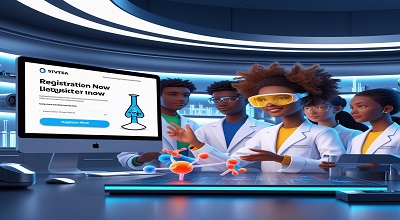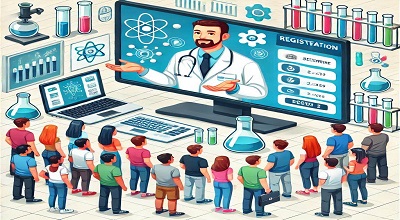Virtual Lab
Virtual Lab: In the ever-evolving world of education and technology, virtual labs have emerged as a revolutionary tool for learning. They provide students, educators, and professionals with an interactive, hands-on experience in a digital environment. Whether you’re a teacher looking to enhance your pedagogy or a student eager to explore complex concepts, virtual labs offer a safe, accessible, and engaging way to learn. This article will explore what virtual labs are, their benefits, how they work, and a step-by-step guide on how to register for one. Additionally, we’ll address some frequently asked questions to help you better understand this innovative learning tool.
What is a Virtual Lab?
A virtual lab is a simulated environment that replicates real-world laboratory settings, allowing users to perform experiments, practice skills, or explore concepts without the need for physical equipment. These labs are typically hosted online and can be accessed via a computer, tablet, or smartphone with an internet connection. Virtual labs are widely used in various fields, including science, engineering, medicine, and even business training. They provide a hands-on learning experience in a controlled, risk-free environment, making them an excellent alternative to traditional labs.
Key Features of Virtual Labs
- Interactive Simulations: Virtual labs use advanced simulations to mimic real-world scenarios, enabling users to experiment and learn by doing.
- Accessibility: They can be accessed anytime, anywhere, making them ideal for remote learning.
- Cost-Effective: Virtual labs eliminate the need for expensive equipment and materials, reducing costs for institutions and learners.
- Safe Learning Environment: Students can make mistakes and learn from them without the risks associated with physical experiments.
- Customizable Content: Educators can tailor virtual labs to suit specific learning objectives or curricula.
How Do Virtual Labs Work?
Virtual labs operate through cloud-based platforms or software applications. Here’s a breakdown of how they work:
- Accessing the Platform: Users log in to a virtual lab platform, such as vlab.co.in or other similar websites.
- Choosing a Lab: Depending on the subject or topic, users select a specific lab or experiment they want to perform.
- Interactive Tools: The platform provides tools, instruments, and materials in a virtual format. For example, in a chemistry lab, users might mix virtual chemicals to observe reactions.
- Guided Learning: Many virtual labs include step-by-step instructions, videos, or tutorials to guide users through the experiment.
- Feedback and Assessment: After completing the experiment, users often receive feedback or assessments to evaluate their understanding.
Benefits of Virtual Labs
Virtual labs offer numerous advantages for both educators and learners. Here are some of the key benefits:
1. Enhanced Learning Experience
Virtual labs provide an immersive and interactive learning experience. Students can visualize complex concepts, conduct experiments, and gain practical skills without the limitations of a physical lab.
2. Flexibility and Accessibility
With virtual labs, learning is no longer confined to a specific location or time. Students can access the labs from anywhere, making them ideal for remote or hybrid learning environments.
3. Cost Savings
Traditional labs require expensive equipment, materials, and maintenance. Virtual labs eliminate these costs, making quality education more affordable and accessible.
4. Safe Environment
In fields like chemistry or medicine, experiments can involve risks. Virtual labs allow students to practice and learn without any danger, fostering confidence and competence.
5. Scalability
Virtual labs can accommodate a large number of users simultaneously, making them suitable for institutions with high enrollment numbers.
6. Real-Time Feedback
Many virtual labs provide instant feedback, helping students identify mistakes and improve their understanding.
How to Register for a Virtual Lab?
Registering for a virtual lab is a straightforward process. Follow these steps to get started:
Step 1: Choose a Platform
Research and select a virtual lab platform that suits your needs. Some popular platforms include:
- Vlab.co.in for science and engineering experiments 1.
- PraxiLabs for e-learning in STEM fields.
- CloudShare for virtual training labs.
Step 2: Create an Account
Visit the platform’s website and sign up for an account. You’ll typically need to provide basic information such as your name, email address, and institution.
Step 3: Select a Course or Lab
Browse the available courses or labs and choose the one that aligns with your learning objectives. Many platforms categorize labs by subject or difficulty level.
Step 4: Complete the Registration Process
Follow the platform’s registration process, which may include:
- Filling out a registration form.
- Paying a fee (if applicable).
- Verifying your email address.
Step 5: Access the Lab
Once registered, log in to your account and start exploring the virtual lab. Most platforms provide tutorials or guides to help you get started.
Applications of Virtual Labs
Virtual labs are used in various fields and industries. Here are some examples:
1. Education
Virtual labs are widely used in schools, colleges, and universities to teach subjects like physics, chemistry, biology, and engineering. They provide students with hands-on experience without the need for physical lab setups.
2. Corporate Training
Many companies use virtual labs for employee training. For example, IT firms use virtual labs to teach coding, software development, and cybersecurity skills.
3. Medical Training
In the medical field, virtual labs are used to train students in anatomy, surgery, and diagnostics. They allow learners to practice procedures in a risk-free environment.
4. Research and Development
Researchers use virtual labs to simulate experiments and test hypotheses before conducting physical trials.
Challenges of Virtual Labs
While virtual labs offer numerous benefits, they also come with some challenges.
- Technical requirements: Users need a reliable internet connection and compatible devices to access virtual labs.
- Learning Curve: Some users may find it challenging to adapt to the virtual format, especially if they’re accustomed to traditional labs.
- Limited Scope: Certain experiments or procedures may not be fully replicable in a virtual environment.
FAQs About Virtual Labs
1. What is the purpose of a virtual lab?
The purpose of a virtual lab is to provide a safe, accessible, and cost-effective platform for learning and experimentation. It allows users to gain practical skills and knowledge without the need for physical equipment.
2. Are virtual labs free to use?
Some virtual labs are free, while others require a subscription or one-time payment. Platforms like vlab.co.in offer free access to many labs.
3. Can virtual labs replace traditional labs?
Virtual labs complement traditional labs but may not fully replace them. They are ideal for remote learning and theoretical understanding but may lack the tactile experience of physical labs.
4. What subjects can be taught using virtual labs?
Virtual labs are used in a wide range of subjects, including physics, chemistry, biology, engineering, medicine, and computer science.
5. Do virtual labs provide certifications?
Some platforms offer certifications upon completing courses or experiments, which can be valuable for academic or professional purposes.
6. What are the technical requirements for using a virtual lab?
To use a virtual lab, you’ll need a computer, tablet, or smartphone with internet access. Some platforms may have additional software or hardware requirements.
7. How do educators integrate virtual labs into their teaching?
Educators can integrate virtual labs into their curriculum by assigning experiments, using them for demonstrations, or incorporating them into assessments.
Conclusion
Virtual labs are transforming the way we learn and teach. They offer a flexible, cost-effective, and engaging alternative to traditional labs, making quality education accessible to a broader audience. Whether you’re a student, educator, or professional, virtual labs provide an excellent platform for exploring new concepts, practising skills, and achieving your learning goals. By following the steps outlined in this article, you can easily register for a virtual lab and start your journey toward interactive, hands-on learning. Embrace the future of education with virtual labs and unlock endless possibilities!

